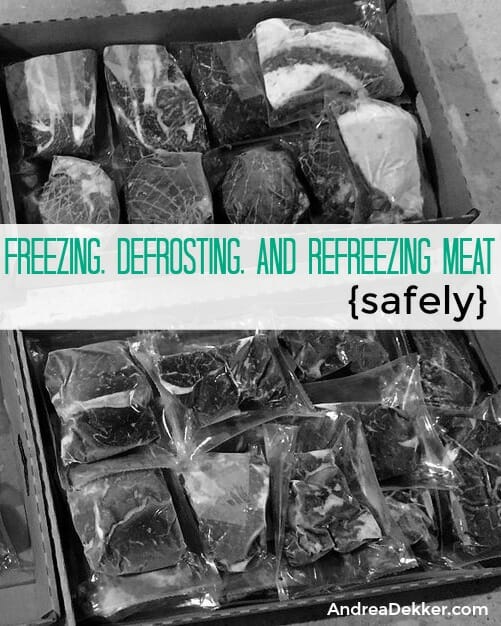
Over the course of my adult life, freezing cooked and uncooked meats has been one of my biggest and best time, money, energy, and sanity-saving tips.
I have saved time by cooking several pounds of meat at once, I have saved money by stocking up when meat is on sale, I have saved energy by preparing simple foods with the ready-to-eat meats in our freezer, and I have saved my sanity by always having SOMETHING I can quickly heat up when my people are requesting yet another meal 🙂

Aww, look how cute Nora was 3 years ago!
I’ve shared much of my love for freezer-cooking here on my blog, and every time I share another freezer-cooking post, I get countless questions about how to safely freeze (and refreeze) meat.
I’ll admit, I’m NOT an expert!
But after getting a quarter of a cow as a Christmas gift last year, and after purchasing MANY pounds of chicken breasts from Zaycon Fresh a few months later, I decided it was finally time that I did a little research as to what exactly is a “safe” way to freeze, defrost, and refreeze meat.
NOTE: I put “safe” in quotations because (as I’m sure you can imagine) almost everything I read, heard, or learned was deemed “unsafe” in a different study or by a different source. So I used some common sense and stuck with the resources that seemed to be most widely accepted, and the advice from trusted sources (like a local butcher and The Food Network).
I’m sure there will be disagreements with some of the things I mention in the post — that’s fine. I will not be offended!
Here are MY answers to the questions I get over and over again — feel free to add any additional information (or ask additional questions) in the comments.
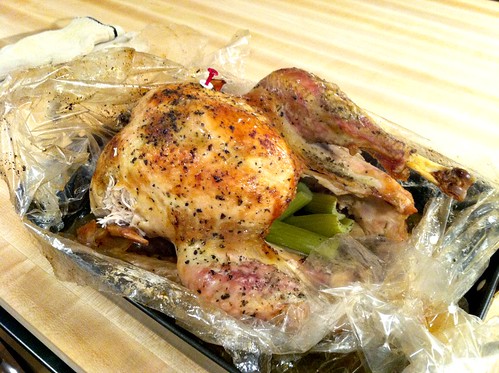
The Types of Meat to Freeze:
Frankly, I’ve had success freezing almost ANY type of meat — spiral hams, turkeys, chicken breasts, whole chickens, shrimp, other seafood, beef roasts, steak, sausage, bacon, hot dogs, brats, pork loins, pork chops, you name it.
I guess I’ve never tried to freeze a lobster before — but I’m sure you could do it if you really wanted to!
Also, as we’ll discuss more below, you can easily (and safely) freeze both cooked and uncooked meats.
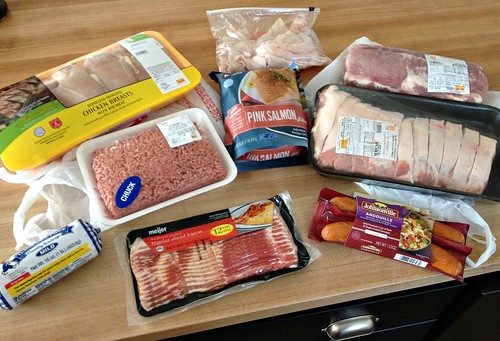
What Happens When Meat Freezes:
Freezing anything (especially meats) ruptures some of the cell walls, which is why many people complain that frozen food doesn’t taste quite as good as fresh.
When you freeze, defrost, and refreeze an item, the second thaw will rupture even more of the cells, leaching out moisture and flavor, and changing the integrity of the product.
So while your frozen food might still be “safe” to eat after multiple freezing / defrosting cycles, it certainly won’t taste as yummy. As far as I know, freezing meat will not change the nutritional value — so even if it doesn’t taste quite as good, you’re still getting the vitamins and nutrients from the meat!
That said, freezing is still the best, easiest, and fastest way to preserve meat, as it drastically slows the enzyme activity that can lead to the deterioration of food quality.
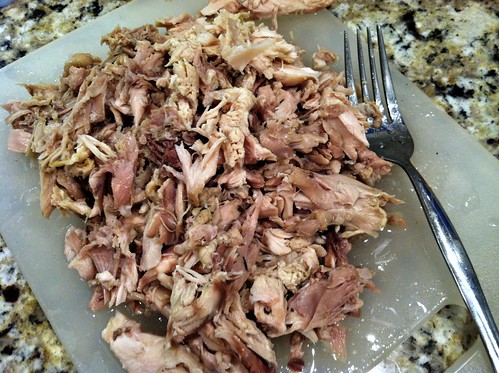
The Best Way to Freeze Meats:
As with most freezer foods, you want to make sure your meat is packaged well before you put it in the freezer (especially if you’re planning to keep it in the freezer for several months.)
This can be as simple as buying a few packages of freezer bags from the store. I don’t get too crazy, but I do usually try to use “freezer bags” as opposed to the thinner zip-top bags if I know my food will be in the freezer for a while.
Also, I have read and heard from numerous sources that using a manual defrost freezer (as opposed to a frost-free freezer) helps prevent freezer burn because the temperature doesn’t fluctuate nearly as much.
It’s almost impossible to find a “manual defrost freezer” that is connected to a refrigerator — so our fridge/freezer combo in our kitchen is a frost-free freezer. However, our deep freezer in the basement is a manual defrost freezer, and we defrost it every 2 years.
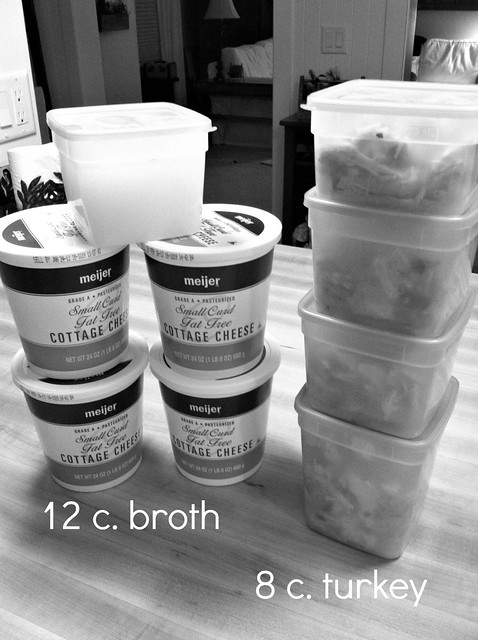
The 3 Safe Ways to Defrost Meat:
Apparently, defrosting meat by setting it on my counter for several hours is not safe 🙂
Yes, I DO actually know this, but I confess that I have defrosted meat on the counter before. Thankfully, we’ve never experienced any adverse side effects! However, according to many of the studies I’ve read, there are only 3 truly safe ways to defrost meat…
1. In the refrigerator.
This is definitely the “best” and most highly recommended method to defrost meat (or pretty much any food). However, it also requires the most planning ahead. Large cuts of meat could easily take 2-4 days to fully defrost in your refrigerator — which is when meal planning comes in handy.
The reason defrosting your meat in the refrigerator is the preferred method is because the meat never gets warmer than 32ºF (the temperature of most refrigerators) so there is very little chance of bacteria multiplying or spreading within the meat — assuming you plan to cook it once it’s defrosted.
2. In cold water.
If you put your meat in a water-tight plastic bag, you can defrost it in a cold water bath.
The trick to this though is that you’ll need to change the water every 30-45 minutes AND make sure the bag doesn’t let any water in. If it does, your meat will most likely absorb some of the water (creating a watery, non-appetizing product) and you’ll also run the risk of bacteria entering your meat from the water, air, or surrounding environment (like any bacteria in your sink).
The cold water method always grosses me out so I never defrost meat this way. I do use this method for frozen fruits and veggies though.
3. In the microwave.
Apparently defrosting in the microwave is a safe way to quickly defrosts the meat — HOWEVER, if you care about the taste or texture of your meat, you most likely won’t want to use the microwave to defrost your meat (trust me, I’ve tried it many times when I’m in a pinch and the results are never that tasty!)
If you do ever defrost your meat in the microwave, you’ll want to cook it immediately after defrosting it.
Also, if you are defrosting ground beef or ground turkey to use in burger patties or meatloaf, it will NOT stick together to form patties or a loaf if it has been defrosted via the microwave (yup, I know this one from experience too!)
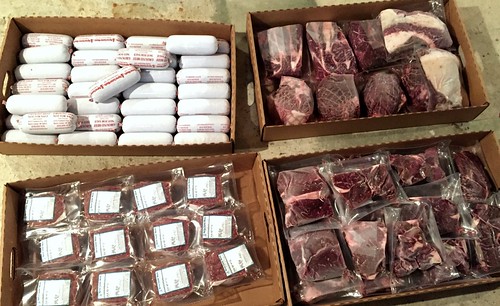
Refreezing Defrosted Meats:
Once your meat is defrosted, the most logical next step would be to cook it — however, if you don’t end up needing all of it (or if you’re just cooking up a bunch of meat to use in future recipes) it IS considered safe to refreeze meat that was already frozen AS LONG AS it is was defrosted properly… a.k.a. not on the counter!
If raw or cooked meat is thawed in the refrigerator, it IS safe to refreeze it WITHOUT cooking it (although there may be a loss of quality due to the moisture lost through thawing.) And it is certainly OK to freeze after cooking it.
Also, if previously cooked meats are thawed in the refrigerator, it is considered safe to refreeze the unused portion as long as it hasn’t been left out of the refrigerator for more than 2 hours.
Here are a few examples:
I buy a frozen turkey and roast it in the oven but we obviously can’t eat all that turkey. So I shred the turkey and refreeze it in several smaller containers.
I get a huge amount of ground beef when it goes on sale and I put it all in the freezer. A few months later, I defrost 3 or 4 pounds to fry, divide up the cooked meat into smaller containers, and put the cooked meat back into the freezer.
I defrost several pounds of ground beef to make a few meatloafs. Once the meat is defrosted, I add the ingredients to make my meatloafs, form the meatloafs, cook one meatloaf for dinner, and put the other UNCOOKED meatloafs back in the freezer.
I defrost a bunch of chicken breasts, boil them, shred them, and divide them up into small portions. Most of the meat goes in the freezer, but I use some to make chicken lasagna. After we eat, I put few leftover pieces of lasagna into small containers for future lunches and put those containers into the freezer.
I have verified these examples with my sources and they all check out to be safe ways to refreeze defrosted meats.
I think the key is to make sure the meat is defrosted in the refrigerator (and not on the counter!) If you safely defrost the meat, it’s usually safe to refreeze it again as well.
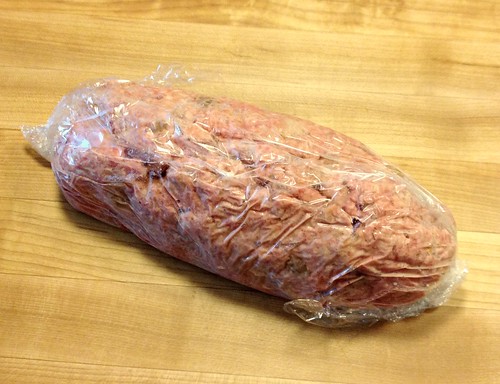

Davetta Langham says
I had meat in my sons freezer that went into an ice chest to take to my home 3 hrs. away. Done this many times and it stays frozen. However, this time I had lamb chops & pork chops that were smoked (cooked) and I had bought fish sticks & orange chicken from freezer section at the store. All was put into the ice chest along with milk, eggs and a few other items. The trip turned into 2 days. The meat was thawed but still extremely cold and the milk etc. was still cold. The ice was unmelted in the ice chest. I put all meat in my freezer when we got home and the other things in the fridge. The milk & eggs, fruit etc. are all good. I’ve eaten them. So, my question is…. is the meat ok to eat.
Andrea says
Honestly, there’s really no way I can answer this question. I guess just use your own personal judgement! Sorry!
Teresa Bishop says
My son took a pork loin and put it in the sink to defrost but forgot to put cold water in it. Can you refreeze it and will it be safe to eat
Andrea says
Honestly, I think it should be fine. However, if you’re unsure, you could always just cook it now and then freeze the already cooked meat.
Pat says
I just defrosted our freezer. Since it sits in the garage it has to be defrosted about twice a year. I take everything out and sort it into laundry baskets. I usually do this on a relatively warm day. Once it’s empty I prop the door open and put a tower fan in the door space, on high and go away for about an hour. When I come back it’s usually completely defrosted so I wipe it out, put my food back in, turn it on, shut the door. Because it’s done quickly and the frozen food is all sorted and covered it stays frozen. I have tried to find a place in the house rather than the garage but to no avail, we have no basement in Oklahoma, the water table is too high and basements here tend to leak.
Marguerite says
Instead of laundry baskets use insulated coolers for content of freezer-while waiting for freezer to defrost.
Jennifer says
Ok so I have an 8 lb pork loin which I bought last Wed and stuck in the freezer (stupidly without dividing it first). I took it out Fri to start defrosting (on the counter all morning – bad girl, I know) and then realizing it wasn’t going to be defrosted in time to make for dinner (duh), stuck it in the fridge to continue defrosting until the weekend when I could cook it all up. Needless to say, it’s still in the fridge, since we chose other options for dinner (I have never been a good meal planner). So now, I am planning on crockpotting half of it tonight (Wed) and roasting the rest tomorrow. Do you think it’s gone bad by now? I really don’t want to chuck 8 lbs of pork, but don’t want to get my family sick either.
Andrea says
I think it should be fine, but I would put leftovers in the freezer sooner than later.
Also, in general, you probably didn’t need to put the pork loin in the freezer on Wednesday if you were planning to cook it on Friday — it would be totally fine in the fridge for Thursday and you’d probably preserve more of the flavor as well 🙂
Debbie says
Thank you for all the info, and verifying them with your sources for us. I’ve done the counter defrosting many times and I blame it on my mom :-). None of us has ever gotten sick from it, thank goodness.
Andrea says
yeah, I’ve done it MANY times too and we’ve never gotten sick. 🙂
Rose says
Thx for the informational post!!!! Love your daily posts!!! You mentioned the zaycon chicken breasts…can you plz let me know if you would recommend that service…I just found out about it and we do get it in our area. Are the chicken breasts all individually wrapped? Or, 49lbs in a box–loose? How do you store those? Thx for your time
Andrea says
so Zaycon Fresh is a great service — BUT the meat usually just comes in a ginormous box all mixed together. The breasts are NOT individually wrapped, so it’s a bit of a pain the first day I bring it home.
I usually always plan to divvy up (and cook) the meat that first day.
So I’ll cook A BUNCH of it and shred it all for the freezer. Then I’ll package more of the uncooked breasts into smaller freezer bags for grilling or using in recipe.
Also, I often split the 40 pounds with my sister or mom — so I don’t have to deal with all 40 pounds at once 🙂
Avia says
Good information! I confess to unthawing on the counter. I’ll have to try to break that habit.
Andrea says
eh, we’ve all done it 🙂
Eileen says
Hi Andrea.
Love ur blog. Quick question do u always defrost ur frozen meat eg frozen chopped chicken breast for enchiladas etc could u not just add these frozen?
Andrea says
Yeah, I almost always defrost it at least enough so the chicken chunks aren’t all stuck together — otherwise it’s really hard (basically impossible) to mix the meat with the suace and other filling ingredients.